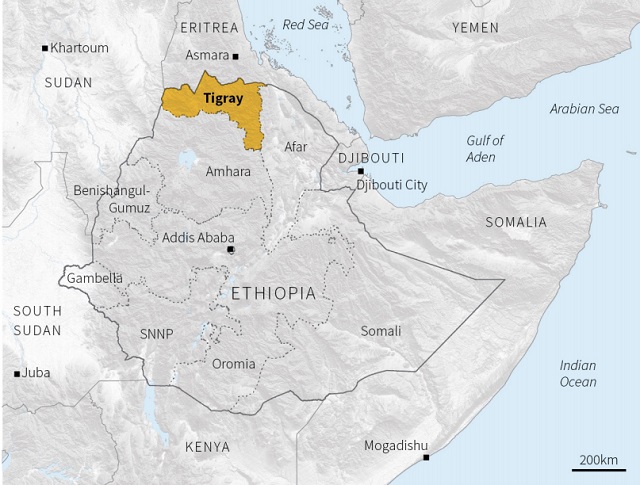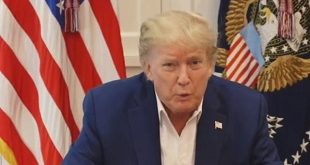
What has the fighting been about? And why? What does this recent truce mean for Ethiopia, Tigray and conflict participants like Eritrea?
Lagos, Nigeria | RICHARD ALI – BIRD AGENCY | The Ethiopian conflict centred on the Tigray region has concerned African security watchers since November 2020, when the fighting started. Last week, the former Nigerian president, Olusegun Obasanjo, announced a cessation of hostilities in his capacity as the African Union’s High Representative for the Horn of Africa.
This unexpected but welcome development likely will not have been possible without the regional knowledge of Uhuru Kenyatta, former president of Kenya, who serves as Special Peace Envoy for Ethiopia, with Phumzile Mlambo-Ngcuka, South Africa’s former Deputy President, completing the troika.
The peace deal represents a fine moment for the AU, which has been keen to emphasise African solutions to Africa’s often very complex problems.
The present conflict has been rooted in the state reconfiguration that happened in 1991 when an armed uprising led by a national coalition—the Ethiopian People’s Revolutionary Democratic Front (EPRDF)—founded and led by the Tigray People’s Liberation Front (TPLF), overthrew the ruling Derg regime.
At the centre of the Tigray crisis is the question of what sort of state organisation works best for Ethiopia and how to run it. The ethnic federation model adopted in Ethiopia post-Derg created a socio-political vortex around a central power base in the EPRDF.
The EPRDF, which has remained the ruling party in that country, comprises four blocs corresponding to the Tigray, Oromo, Amhara, and Southern Nationalities ethnolinguistic groups. The leader of the EDPRF automatically becomes prime minister of Ethiopia on account of the overwhelming parliamentary majority the Front has always produced.
The system worked so long as the blocs worked together and power was shared fairly. In practice, there was always a greater tendency for the federating ethnic groups — Tigray, Oromia, Afar, Somali, and Amhara mainly — to maintain distinct identities and local loyalties over a composite Ethiopian identity as these were what granted access to power. This arrangement worked out well for the Tigrayans and the TPLF while the powerful and charismatic Meles Zenawi, who had defeated the Derg, was in charge.

After Zenawi died in 2012, simmering tensions over what was seen as the TPLF bloc’s oversized influence in governance and the economy, as well as the huge disparity in populations of the federating units in a one-man-one-vote democracy, exacerbated a political crisis. Tigray is only the fourth most populous state, falling far behind Oromia, Amhara, and Somali; it is also the fourth largest in landmass.
Abiy Ahmed inherited this lockstep when he became prime minister in 2018 and soon attempted to change Ethiopia’s power dynamics, seeking to deemphasise ethnolinguistic affiliation in favour of a pan-Ethiopian identity. Under Abiy’s leadership, the EPRDF re-formed itself into the Prosperity Party. The Tigrayan-TPLF bloc opposed this move and did not join the new party, returning instead to the Tigrayan heartland, where armed rebellion against the federal government soon began. Beyond the idea of being a multi-ethnic party with a shared vision, the extent to which the PP differs from the EPRDF is unclear, as its structures remain based on the same ethnolinguistic internal organisational structure.
Abiy’s reforms have been praised for their strategic necessity, but the pacing of their delivery has raised questions about the abilities of the 2020 Nobel Peace Prize laureate. Allowing the TPLF, which founded and has been at the core of the ruling party for so long, to feel side-lined in any re-formation agenda was short-sighted in that it left little option on the table for the Tigrayans but rebellion.
As can be seen with the internal organisation of the new Prosperity Party, the political settlement of 1991 goes to the very heart of what modern Ethiopia means. Such a basis can only be re-negotiated and differences mediated, much like the African Union has done, ending a needless conflict in which hundreds of thousands have been killed, with millions displaced.
The African Union peace process is commendable, bringing all parties to the table and working out a truce. In reading the terms of the cessation of hostilities, however, the Ethiopian federal government seems to have decisively “won”, with the TPLF being bound to disarm its militia fully. But this follows a conflict in which numerous human rights violations and extrajudicial killings have occurred on both sides.
It also remains unclear how this truce will affect international participation in the conflict—primarily Eritrean—and the activities of militias from another part of Ethiopia—primarily the Amhara—in the fighting.
What is clear, though, is the possibility of a new starting point for Ethiopia if the principal actors—Tigrayan, Amhara, Oromo, and others—can achieve a reconfiguration of the state without resulting in the use of arms and with far less of the ethnic hate speech and hostile narratives seen over the last few years. This can only be done in an all-inclusive process driven by a need to achieve a political balance based on mutual respect, democracy, and mediation of difference.
******
SOURCE: bird story agency
**Richard Ali is a Nigerian lawyer and expert in internal security matters, particularly preventing and countering violent extremism (PCVE). He used to maintain a column on security issues at Daily Nigerian. He is the CEO of Engaging Borders SRD.
 The Independent Uganda: You get the Truth we Pay the Price
The Independent Uganda: You get the Truth we Pay the Price


